#Kathleen Lake
Text

A picnic spot forever worth the sore feet and skinned palms. 📍Kathleen Lake, Yukon Territory, Canada
425 notes
·
View notes
Photo
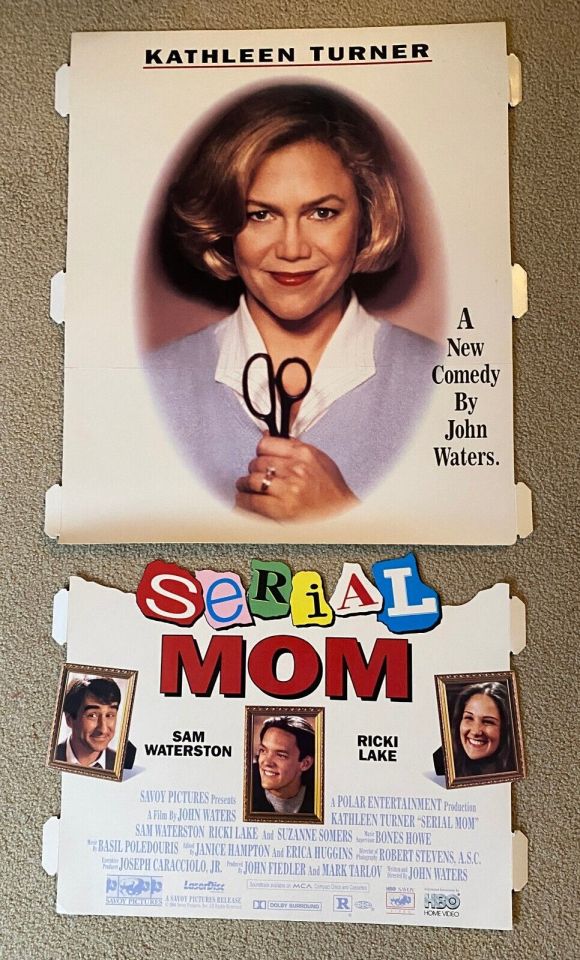
214 notes
·
View notes
Text

13 notes
·
View notes
Text

Serial Mom
#Serial Mom#john waters#kathleen Turner#the suburbs#serial killers#sam waterson#ricki lake#comedy#matthew lillard
8 notes
·
View notes
Text
In 2008, Supreme Court Justice Clarence Thomas decided to send his teenage grandnephew to Hidden Lake Academy, a private boarding school in the foothills of northern Georgia. The boy, Mark Martin, was far from home. For the previous decade, he had lived with the Justice and his wife in the suburbs of Washington, D.C. Thomas had taken legal custody of Martin when he was 6 years old and had recently told an interviewer he was “raising him as a son.”
Tuition at the boarding school ran more than $6,000 a month. But Thomas did not cover the bill. A bank statement for the school from July 2009, buried in unrelated court filings, shows the source of Martin’s tuition payment for that month: the company of billionaire real estate magnate Harlan Crow.
The payments extended beyond that month, according to Christopher Grimwood, a former administrator at the school. Crow paid Martin’s tuition the entire time he was a student there, which was about a year, Grimwood told ProPublica.
“Harlan picked up the tab,” said Grimwood, who got to know Crow and the Thomases and had access to school financial information through his work as an administrator.
Before and after his time at Hidden Lake, Martin attended a second boarding school, Randolph-Macon Academy in Virginia. “Harlan said he was paying for the tuition at Randolph-Macon Academy as well,” Grimwood said, recalling a conversation he had with Crow during a visit to the billionaire’s Adirondacks estate.
ProPublica interviewed Martin, his former classmates and former staff at both schools. The exact total Crow paid for Martin’s education over the years remains unclear. If he paid for all four years at the two schools, the price tag could have exceeded $150,000, according to public records of tuition rates at the schools.
Thomas did not report the tuition payments from Crow on his annual financial disclosures. Several years earlier, Thomas disclosed a gift of $5,000 for Martin’s education from another friend. It is not clear why he reported that payment but not Crow’s.
The tuition payments add to the picture of how the Republican megadonor has helped fund the lives of Thomas and his family.
“You can’t be having secret financial arrangements,” said Mark W. Bennett, a retired federal judge appointed by President Bill Clinton. Bennett said he was friendly with Thomas and declined to comment for the record about the specifics of Thomas’ actions. But he said that when he was on the bench, he wouldn’t let his lawyer friends buy him lunch.

Thomas did not respond to questions. In response to previous ProPublica reporting on gifts of luxury travel, he said that the Crows “are among our dearest friends” and that he understood he didn’t have to disclose the trips.
ProPublica sent Crow a detailed list of questions and his office responded with a statement that did not dispute the facts presented in this story.
“Harlan Crow has long been passionate about the importance of quality education and giving back to those less fortunate, especially at-risk youth,” the statement said. “It’s disappointing that those with partisan political interests would try to turn helping at-risk youth with tuition assistance into something nefarious or political.” The statement added that Crow and his wife have “supported many young Americans” at a “variety of schools, including his alma mater.” Crow went to Randolph-Macon Academy.
GET IN TOUCH
ProPublica plans to continue reporting on the Supreme Court. If you have information we should know, please get in touch. Josh Kaplan can be reached by email at [email protected] and by Signal or WhatsApp at 734-834-9383. Justin Elliott can be reached by email at [email protected] or by Signal or WhatsApp at 774-826-6240.
Crow did not address a question about how much he paid in total for Martin’s tuition. Asked if Thomas had requested the support for either school, Crow’s office responded, “No.”
Last month, ProPublica reported that Thomas accepted luxury travel from Crow virtually every year for decades, including international superyacht cruises and private jet flights around the world. Crow also paid money to Thomas and his relatives in an undisclosed real estate deal, ProPublica found. After he purchased the house where Thomas’ mother lives, Crow poured tens of thousands of dollars into improving the property. And roughly 15 years ago, Crow donated much of the budget of a political group founded by Thomas’ wife, which paid her a $120,000 salary.
“This is way outside the norm. This is way in excess of anything I’ve seen,” said Richard Painter, former chief White House ethics lawyer for President George W. Bush, referring to the cascade of gifts over the years.
Painter said that when he was at the White House, an official who’d taken what Thomas had would have been fired: “This amount of undisclosed gifts? You’d want to get them out of the government.”
A federal law passed after Watergate requires Justices and other officials to publicly report most gifts. Ethics law experts told ProPublica they believed Thomas was required by law to disclose the tuition payments because they appear to be a gift to him.
Justices also must report many gifts to their spouses and dependent children. The law’s definition of dependent child is narrow, however, and likely would not apply to Martin since Thomas was his legal guardian, not his parent. The best case for not disclosing Crow’s tuition payments would be to argue the gifts were to Martin, not Thomas, experts said.
But that argument was far-fetched, experts said, because minor children rarely pay their own tuition. Typically, the legal guardian is responsible for the child’s education.
“The most reasonable interpretation of the statute is that this was a gift to Thomas and thus had to be reported. It’s common sense,” said Kathleen Clark, an ethics law expert at Washington University in St. Louis. “It’s all to the financial benefit of Clarence Thomas.”
Martin, now in his 30s, told ProPublica he was not aware that Crow paid his tuition. But he defended Thomas and Crow, saying he believed there was no ulterior motive behind the real estate magnate’s largesse over the decades. “I think his intentions behind everything is just a friend and just a good person,” Martin said.
Crow has long been an influential figure in pro-business conservative politics. He has given millions to efforts to move the law and the judiciary to the right and serves on the boards of think tanks that publish scholarship advancing conservative legal theories.
Crow has denied trying to influence the Justice but has said he extended hospitality to him just as he has to other dear friends. From the start, their relationship has intertwined expensive gifts and conservative politics. In a recent interview with The Dallas Morning News, Crow recounted how he first met Thomas. In 1996, the Justice was scheduled to give a speech in Dallas for an anti-regulation think tank. Crow offered to fly him there on his private jet. “During that flight, we found out we were kind of simpatico,” the billionaire said.
The following year, the Thomases began to discuss taking custody of Martin. His father, Thomas’ nephew, had been imprisoned in connection with a drug case. Thomas has written that Martin’s situation held deep resonance for him because his own father was absent and his grandparents had taken him in “under very similar circumstances.”
Thomas had an adult son from a previous marriage, but he and wife, Ginni, didn’t have children of their own. They pitched Martin’s parents on taking the boy in.
“Thomas explained that the boy would have the best of everything — his own room, a private school education, lots of extracurricular activities,” journalists Kevin Merida and Michael Fletcher reported in their biography of Thomas.
Thomas gained legal custody of Martin and became his legal guardian around January 1998, according to court records.
Martin, who had been living in Georgia with his mother and siblings, moved to Virginia, where he lived with the Justice from the ages of 6 to 19, he said.
Living with the Thomases came with an unusual perk: lavish travel with Crow and his family. Martin told ProPublica that he and Thomas vacationed with the Crows “at least once a year” throughout his childhood.
That included visits to Camp Topridge, Crow’s private resort in the Adirondacks, and two cruises on Crow’s superyacht, Martin said. On a trip in the Caribbean, Martin recalled riding jet skis off the side of the billionaire’s yacht.
Roughly 20 years ago, Martin, Thomas and the Crows went on a cruise on the yacht in Russia and the Baltics, according to Martin and two other people familiar with the trip. The group toured St. Petersburg in a rented helicopter and visited the Yusupov Palace, the site of Rasputin’s murder, said one of the people. They were joined by Chris DeMuth, then the president of the conservative think tank the American Enterprise Institute. (Thomas’ trips with Crow to the Baltics and the Caribbean have not previously been reported.)
Thomas reconfigured his life to balance the demands of raising a child with serving on the high court. He began going to the Supreme Court before 6 a.m. so he could leave in time to pick Martin up after class and help him with his homework. By 2001, the justice had moved Martin to private school out of frustration with the Fairfax County public school system’s lax schedule, The American Lawyer magazine reported.
For high school, Thomas sent Martin to Randolph-Macon Academy, a military boarding school 75 miles west of Washington, D.C., where he was in the class of 2010. The school, which sits on a 135-acre campus in the Shenandoah Valley, charged between $25,000 to $30,000 a year. Martin played football and basketball, and the Justice sometimes visited for games.
Randolph-Macon was also Crow’s alma mater. Thomas and Crow visited the campus in April 2007 for the dedication of an imposing bronze sculpture of the Air Force Honor Guard, according to the school magazine. Crow donated the piece to Randolph-Macon, where it is a short walk from Crow Hall, a classroom building named after the Dallas billionaire’s family.
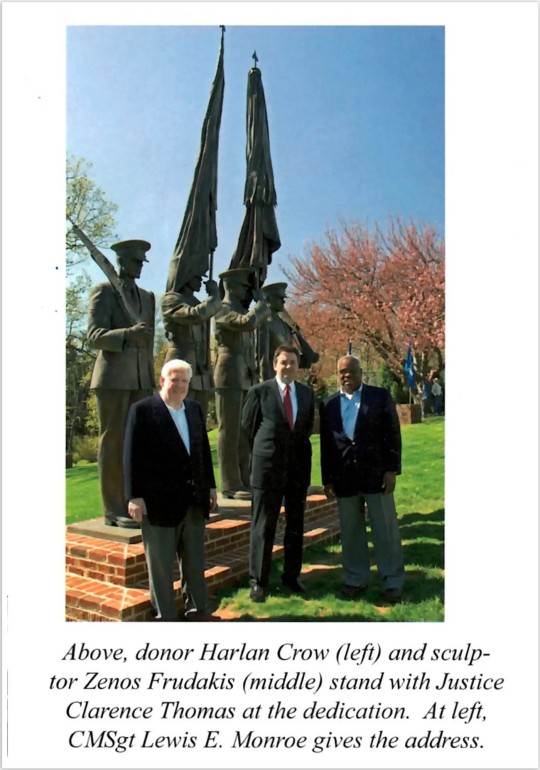
Martin sometimes chafed at the strictures of military school, according to people at Randolph-Macon at the time, and he spent his junior year at Hidden Lake Academy, a therapeutic boarding school in Georgia. Hidden Lake boasted one teacher for every 10 students and activities ranging from horseback riding to canoeing. Those services came at an added cost. At the time, a year of tuition was roughly $73,000, plus fees.
The July 2009 bank statement from Hidden Lake was filed in a bankruptcy case for the school, which later went under. The document shows that Crow Holdings LLC wired $6,200 to the school that month, the exact cost of the month’s tuition. The wire is marked “Mark Martin” in the ledger.
Crow’s office said in its statement that Crow’s funding of students’ tuition has “always been paid solely from personal funds, sometimes held at and paid through the family business.”
Grimwood, the administrator at Hidden Lake, told ProPublica that Crow wired the school money once a month to pay Martin’s tuition fees. Grimwood had multiple roles on the campus, including overseeing an affiliated wilderness program. He said he was speaking about the payments because he felt the public should know about outside financial support for Supreme Court Justices. Martin returned to Randolph-Macon his senior year.
Thomas has long been one of the less wealthy members of the Supreme Court. Still, when Martin was in high school, he and Ginni Thomas had income that put them comfortably in the top echelon of Americans.
In 2006 for example, the Thomases brought in more than $500,000 in income. The following year, they made more than $850,000 from Clarence Thomas’ salary from the Court, Ginni Thomas’ pay from the Heritage Foundation and book payments for the Justice’s memoir.
It appears that at some point in Martin’s childhood, Thomas was paying for private school himself. Martin told ProPublica that Thomas sold his Corvette — “his most prized car” — to pay for a year of tuition, although he didn’t remember when that occurred.
In 2002, a friend of Thomas’ from the RV community who owned a Florida pest control company, Earl Dixon, offered Thomas $5,000 to help defray the costs of Martin’s education. Thomas’ disclosure of that earlier gift, several experts said, could be viewed as evidence that the Justice himself understood he was required to report tuition aid from friends.
“At first, Thomas was worried about the propriety of the donation,” Thomas biographers Merida and Fletcher recounted. “He agreed to accept it if the contribution was deposited directly into a special trust for Mark.” In his annual filing, Thomas reported the money as an “education gift to Mark Martin.”

Do you have any tips on the Supreme Court or the judiciary? Josh Kaplan can be reached by email at [email protected] and by Signal or WhatsApp at 734-834-9383. Justin Elliott can be reached by email at [email protected] or by Signal or WhatsApp at 774-826-6240.
#us politics#news#ProPublica#2023#us supreme court#ethics rules#ethics violations#supreme court ethics violations#scotus#justice clarence thomas#ginni thomas#harlan crow#Mark Martin#Christopher Grimwood#Randolph-Macon Academy#Hidden Lake Academy#Mark W. Bennett#Richard Painter#Kathleen Clark#The Dallas Morning News#Kevin Merida#Michael Fletcher#Camp Topridge#Adirondacks#superyacht#russia#Chris DeMuth#The American Lawyer#Crow Holdings LLC#heritage foundation
23 notes
·
View notes
Text
"Serial Mom" (1994) - John Waters
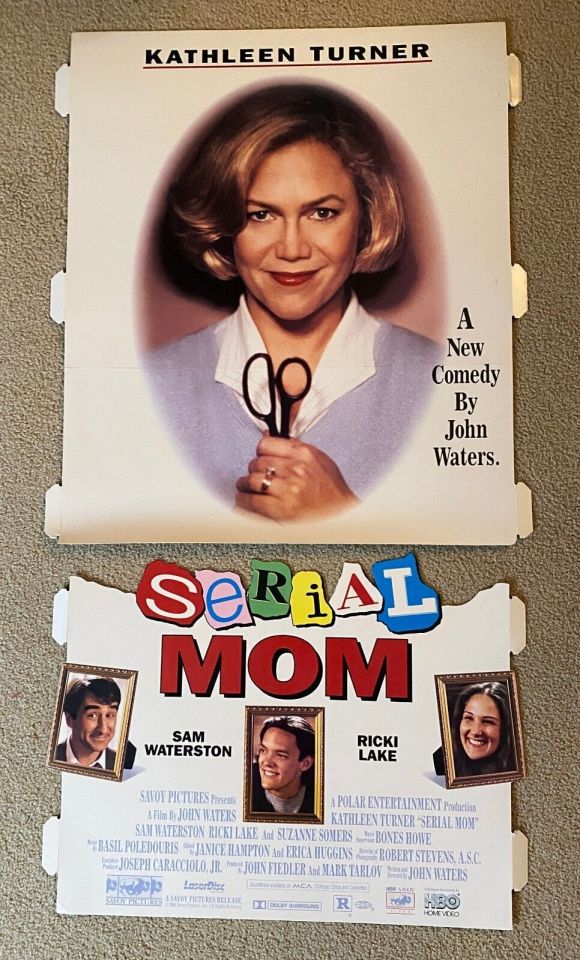
Films I've watched in 2023 (49/119)
#films watched in 2023#Serial Mom#Kathleen Turner#Sam Waterston#Matthew Lillard#Ricki Lake#John Waters#black comedy
13 notes
·
View notes
Text


1985 Demri, when she attended the the Douglas Anderson School of the Arts, Jacksonville, Florida (1985 – 1989).
Photo via @nehistripesseattle
💬 Kathleen Austin, Demri’s mom: I received a call that the school (Douglas Anderson School of the Arts) was taking applications and auditions. 25 applicants were selected from 300! Dem was selected and was so excited I let her stay in Florida. We flew her home for Christmas, she met Kent*, returned to Florida but didn’t stay. She managed to get greyhound bus ticket home
*Kent Lake was Demri’s boyfriend at the time. They broke up somewhere in 1988.
Memories thanks to Memories of Demri on instagram
#demri lara parrott murphy#demri parrott murphy#demriparrott#demri lara parrott#demri parrott#demri murphy#douglas anderson school of the arts#1985#aspiring actress#Kathleen Austin#Kent Lake
10 notes
·
View notes
Photo

#serial mom#kathleen turner#sam waterston#ricki lake#matthew lillard#suzanne somers#john waters#1994
2 notes
·
View notes
Text
muses
#「 𝕨𝕨 」 » courtney ashe#「 𝕨𝕨 」 » becky barnes#「 𝕨𝕨 」 » laura castillo#「 𝕨𝕨 」 » grace chasity#「 𝕨𝕨 」 » donna daggit#「 𝕨𝕨 」 » ruth fleming#「 𝕨𝕨 」 » jeri gibson#「 𝕨𝕨 」 » gary goldstein#「 𝕨𝕨 」 » ethan green#「 𝕨𝕨 」 » miss holloway#「 𝕨𝕨 」 » clover lake#「 𝕨𝕨 」 » linda monroe#「 𝕨𝕨 」 » izzy myers#「 𝕨𝕨 」 » darcy scott#「 𝕨𝕨 」 » kathleen winters#td
0 notes
Text
Environment: Every Drop Counts in America’s Waterways Crisis
The Rio Grande and Colorado Rivers are two of the most threatened rivers in the U.S. National Geographic Photographer Pete McBride is on a mission to protect these vital rivers and their ecosystems.
— July 25, 2023 | Photographs By Pete McBride | By Kathleen Rellihan
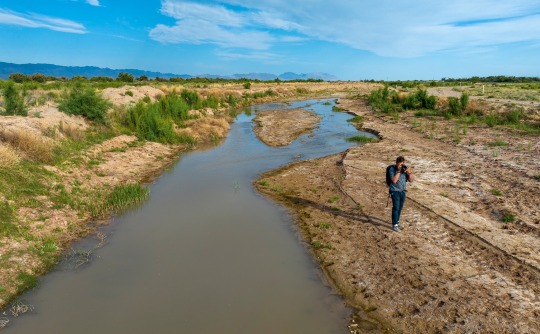
National Geographic Photographer Pete McBride went on assignment to the Rio Grande to capture imagery of the depleted waterway.
Our nation's most vital waterways are drying up at an alarming rate due to global warming, increased human water use, and other man-made impacts. Nowhere is this crisis seen as dramatically than in the American West, with its longest drought in 1,200 years. Two of our nation’s critical lifelines—the Rio Grande and the Colorado River—are shrinking tragically with every passing day.
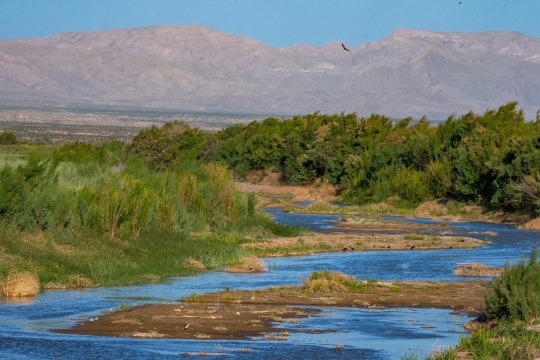
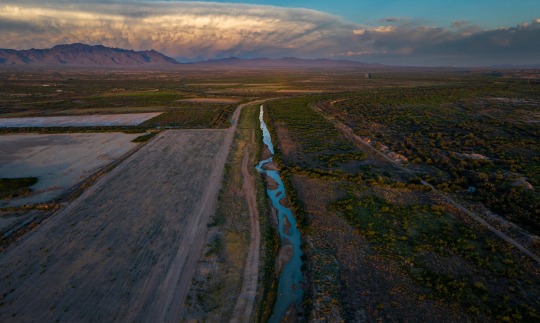
The Rio Grande is one of the most threatened waterways in the United States.
After spending years traveling the world on assignment, National Geographic Photographer Pete McBride realized that the world’s natural places he spent years documenting were changing drastically due to the disappearance of freshwater. He has spent the last two decades trying to bring awareness to this issue through photography and storytelling. Still, McBride calls for individuals and companies to take action to save our rivers and water.
“I hope to make people more aware of how fragile and precious our freshwater systems are—and why we all need to care for them like beloved family members. When we ask too much of them, they simply disappear.”
— Pete McBride, National Geographic Photographer and Explorer
Now, an effort from Finish Dishwashing is also helping to raise awareness of the crisis affecting freshwater resources everywhere. The Finish brand worked with a Texas sculptor to craft a one-of-a-kind sculpture that depicts the very thing it is honoring. Made from limestone that is native to Texas, the monument draws inspiration from rock formations, waterflow, waterfalls, flora, and fauna unique to many of the endangered bodies of water in the Southwest. Placed at the bottom of a lake in an at-risk area in Texas, the HOPEFUL MONUMENT is the first monument created with the hope that it will never be seen—that is, it will not be revealed unless water levels drop drastically low. While most monuments commemorate the past, this one is meant to spur action for the future—to inspire us to protect our most precious resource: water.
“Our drinking water doesn’t come from the tap, but rather rivers and lakes which supply the vast majority of all our water systems. Without them, then our taps will, and they already are, run dry and/or be polluted,” says McBride.
— Pete McBride, National Geographic Photographer and Water Advocate
McBride knows firsthand about the water crisis in the West, as he has documented it in his award-winning film, Chasing Water, and book, The Colorado River: Flowing Through Conflict. A photographer and Colorado native, McBride's mission is to raise awareness for the Colorado River and all American rivers, or arteries, as he refers to them.
After witnessing a dramatic loss of water in the Colorado River near his home, McBride expanded his photography career to be one that’s focused on environmental advocacy to protect the threatened resources of his home region, the American Southwest.
“I hope that combining beautiful imagery and a human story around a tough subject will help the public become more inspired to understand the issue and become more active,” says McBride, who was named a National Geographic Freshwater Hero for his work documenting rivers worldwide.
The National Geographic Photographer says he’s a “curious citizen who cares about his backyard river” and called to protect the waterway. And he’s now calling everyone else to do their part as well.
A Vital River Under Threat: The Rio Grande
On McBride’s latest assignment in Texas, he’s standing in a dried-up riverbed in the Rio Grande River, a spot locals tragically refer to as the “Rio Sand.” Just an hour south of El Paso, America’s fourth longest river is only ankle-deep in some locations. As it flows further south along the U.S./Mexico border, the river will become a trickle—and in many places—it runs completely dry.


The Rio Grande is dotted by dry stretches throughout Texas.
The Rio Grande supports more than 16 million people in the US and Mexico, including 22 indigenous nations. Alarmingly, this vital river system in North America is vanishing at a dramatic rate. Flowing from the Rocky Mountains and later forming the U.S.-Mexico border, this threatened river and its ecosystems have been impacted by agriculture withdrawals, rising temperatures, and unprecedented drought.
“The Rio Grande, just east of El Paso, is the ‘forgotten reach’—by the time it gets here it's a ghost of its former self. Because of a changing climate, severe drought, and asking too much of this limited resource, it's completely drying out.”
— Pete McBride, National Geographic Photographer and Explorer
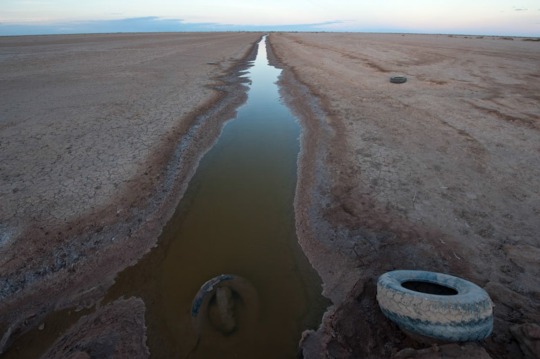
The Rio Grande has seen devastating impacts from climate change. New Mexico, like much of the West, has been battling unusually hot and dry weather for the last two decades. The river has also been hit by historic drought, with the lower Rio Grande, the border between Texas and Mexico, dried up for over a hundred miles.
“Fresh water is one of the most important, limited natural resources,” says McBride as he stands in the barren riverbed. “We can live without oil; we can't live without water.”
America’s Most Endangered River—The Mighty Colorado
Seeing firsthand his own home dry-up in the water crisis had a major impact on the National Geographic Photographer: “I grew up on the [Colorado] River, so I always had a fond love for its beauty and wonder. When I followed it to its end and saw it run completely dry, I realized there needed to be more voices speaking on behalf of the river itself.”
The “lifeline of the West,” as the Colorado River is known, supplies drinking water to 40 million people in the U.S., fuels hydropower in eight states, and is a critical resource for 30 tribal nations and agricultural communities, according to the Bureau of Reclamation. It’s also the most at-risk river in the U.S. and is now considered the most endangered river in the world by conservation nonprofit American Rivers. The once mighty Colorado River has been drying out for the last twenty years due to overuse and historic drought.


Due to overallocation and climate change, the Colorado River has not reached the sea for two decades.
“The Colorado River is the frontline of climate change,” says McBride. “This remarkable river system supports over 5 million acres of farmland, where 95 percent of our winter vegetables come from. If you like eating salads, you are eating the Colorado River.”
As the climate crisis worsens, the water levels plummet. Today, the Colorado River runs at only 50% of its traditional flow, while its largest reservoirs in the United States: Lake Powell and Lake Meade, fell to 22% during the fall of 2022.
Everyday Actions to Save Water
The water crisis is a daunting and undeniably complex issue, but that doesn’t mean that people in their daily life can’t help protect our most valuable resource. If we don’t take action now, there won’t be time to save these rivers, lakes, reservoirs, and other bodies of water, warns McBride.
“Become more aware of your waterways. Our voices can make a difference. Rivers need more advocates,” advises the National Geographic Explorer, adding, “You can use less water by reducing meat consumption (meat requires a lot of water to produce), using less water-intensive, non-native thirsty plants in your yard, like bluegrass, and reducing how often you run your water systems for dishes, etc. We need agriculture as we need to eat; we just need to become more efficient and mindful about everything: from what is on our plate to how we clean them and use our taps."
McBride believes these are just some of the everyday actions we, as consumers, can take. Another small change that will make a ripple of impact? Use your dishwasher and stop pre-rinsing. Finish agrees. The brand has a longstanding history of driving impact and inspiring change through its ‘Skip the Rinse’ purpose campaign, which encourages consumers to skip pre-rinsing their dishes before placing them in the dishwasher, ultimately saving up to 20 gallons of water each time. If we all skipped the rinse, we could save up to 150 billion gallons of water every year.
Other water-saving actions include turning off the shower/faucet while lathering or brushing teeth and installing a greywater recycling system.
“Our fresh water is a limited resource,” warns McBride. “If we don’t get involved on some level, we will [see] more of that resource vanish.”
#Environment#Waterways Crisis#Rio Grande & Colorado Rivers#U.S. National Geographic Photographer Pete McBride#Kathleen Rellihan#American West#Hopeful Monument#Texas Native Limestone#Rock Formations | Waterflow | Waterfalls | Flora and Fauna#McBride: National Geographic Freshwater Hero#Rio Sand#El Paso#U.S. 🇺🇸/Mexico 🇲🇽 Border#Indigenous Nations#Rocky Mountains ⛰️#Agriculture 👨🌾#Hydropower#Tribal Nations | Agricultural Communities#Overuse of Waters | Historic Drought#United States 🇺🇸: Lake Powell | Lake Meade#National Geographic Explorer#Shower/Faucet#Greywater Recycling System#Resource Vanish
0 notes
Text
La Signora Ammazzatutti
Benvenuti o bentornati sul nostro blog. Nello scorso articolo abbiamo ripreso a parlare di animazione e più precisamente della Disney, arrivando a recensire il suo 26° classico ossia Basil l’investigatopo. Un giocattolaio viene rapito per motivi a noi sconosciuti e sua figlia si mette alla ricerca del più grande detective di Londra, Basil per l’appunto. Quando lo trova, inizialmente il detective…
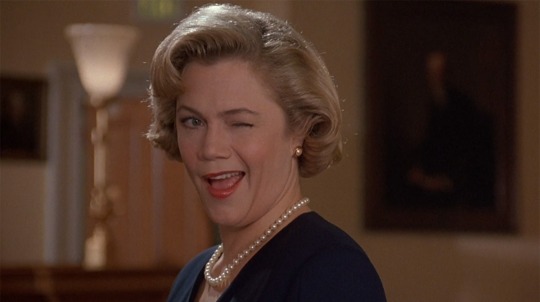
View On WordPress
#Basil Poledouris#Beverly Sutphin#Cecchi Gori Group#commedia#commedia nera#film#ipocrisia#John Fiedler#John Waters#Justin Whalin#Kathleen Turner#La Signora Ammazzatutti#Mark Tarlov#Matthew Lillard#movies#Recensione#Recensione film#Ricki Lake#Robert M. Stevens#Sam Waterson#satira#Scott Morgan#Serial Mom#thriller
0 notes
Text

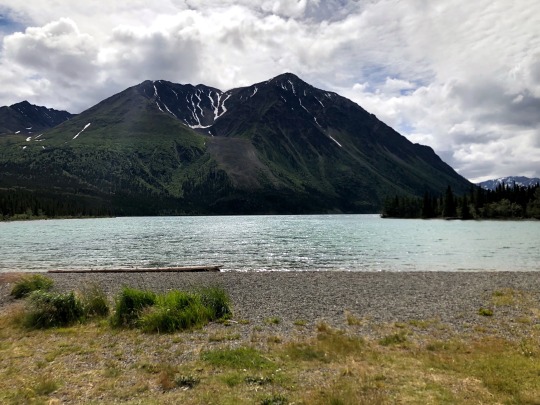
kathleen lake, yukon
1 note
·
View note
Text
Super Podcast Audio Commentary - Serial Mom (1994)
Super Podcast Audio Commentary - Serial Mom (1994)
#Podcast #AudioCommentary #JohnWaters #SerialMom #KathleenTurner #IndiePodcast #PodNation
Super Podcast Audio Commentary
John Waters May Theme Poll
Serial Mom (1994)
Download HERE
https://supermarcey.files.wordpress.com/2022/05/the-super-podcast-audio-commentary-serial-mom-1994.mp3
Welcome back to The Super Podcast and to another FB Group Poll voted audio commentary episode, for May the theme for the poll was John Waters, the options of films were A Dirty Shame (2004), Cecil B.…

View On WordPress
#audio commentary#cult classic#John Waters#Kathleen Turners#Matthew Lillard#podcast#Ricki Lake#Sam Waterston#Serial Mom#Super Podcast
0 notes
Text
MyPillow CEO Mike Lindell says he wants to work with the Republican National Committee to set up an "election crime unit."
"Later in the week, we're setting up the election crime unit, Steve. So everybody, stay tuned. It's going to be big," Lindell said on fellow Trump ally Steve Bannon's "War Room" podcast on Monday.
Lindell told Bannon he has a "plan" for the election crime unit that involves him "going to states" and trying to organize support for the idea.
"And I'm going to be going to states, Steve. I'm not missing a beat. Starting this week, I'm going to be flying into at least three states," the MyPillow CEO said.

Lindell is fresh off a stinging defeat in his run to lead the RNC.
After claiming earlier this month that he had enough votes to derail RNC chair Ronna McDaniel's leadership bid, Lindell ended up getting only four votes. McDaniel on Friday clinched her fourth term as chair, with 111 votes.
But Lindell told Bannon he is still working to "hold the RNC accountable."
"Well, when you work with me, it's election crime, not a weak word like election integrity. It's called the election crime," Lindell said.
It's unclear what Lindell's proposed election crime unit would do. It's also unclear if the RNC has agreed to setting up the unit or working with Lindell on it. Lindell and representatives for the RNC did not immediately respond to Insider's request for comment sent outside regular business hours.
Lindell is best known for pushing baseless voter-fraud claims about the 2020 election. In December 2021, he told Insider he spent $25 million — half of his estimated $50 million net worth — on promoting his claims that the election was stolen from former President Donald Trump.
In April, Lindell told Insider he is bankrolling a nationwide effort to file lawsuits in all 50 states in an effort to stop voting machines from being used in elections. That month, Lindell told Insider he helped fund the Trump-backed gubernatorial candidate Kari Lake and Rep. Mark Finchem's lawsuit in Arizona. This lawsuit was filed against Kathleen Hobbs, Arizona's Secretary of State, and members of the Maricopa and Pima County boards of supervisors. It called for Arizona authorities to halt the use of any electronic voting system. Lake and Finchem's lawsuit failed: In December, the case was dismissed by District Judge John Tuchi, who called it a "frivolous complaint."
Lindell is currently facing a $1.3 billion dollar defamation lawsuit from voting technology company Dominion. Dominion is accusing the MyPillow CEO and his allies of spreading false claims about its role in the 2020 election. Lindell tried to get the lawsuit dismissed, but that attempt failed in March.
#us politics#news#business insider#2023#mike lindell#Republican National Committee#election crime unit#steve bannon#war room podcast#twitter#tweet#Ronna McDaniel#Rep. Mark Finchem#kari lake#Kathleen Hobbs#arizona#Judge John Tuchi#dominion voting systems
6 notes
·
View notes
Text

New Mexico Footprints are Oldest Sign of Humans in Americas
Fossil footprints date back to between 21,000 and 23,000 years ago, upending previous theory that humans reached continent later.
New research confirms that fossil human footprints in New Mexico are probably the oldest direct evidence of human presence in the Americas, a finding that upends what many archaeologists thought they knew.
The footprints were discovered at the edge of an ancient lakebed in White Sands national park and date back to between 21,000 and 23,000 years ago, according to research published on Thursday in the journal Science.
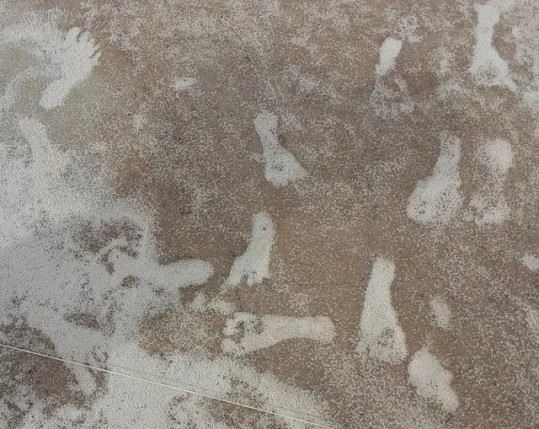
The estimated age of the footprints was first reported in Science in 2021, but some researchers raised concerns about the dates. Questions focused on whether seeds of aquatic plants used for the original dating may have absorbed ancient carbon from the lake – which could, in theory, throw off radiocarbon dating by thousands of years.
The new study presents two additional lines of evidence for the older date range. It uses two entirely different materials found at the site, ancient conifer pollen and quartz grains.
The reported age of the footprints challenges the once conventional wisdom that humans did not reach the Americas until a few thousand years before rising sea levels covered the Bering land bridge between Russia and Alaska, perhaps about 15,000 years ago.
“This is a subject that’s always been controversial because it’s so significant – it’s about how we understand the last chapter of the peopling of the world,” said Thomas Urban, an archaeological scientist at Cornell University, who was involved in the 2021 study but not the new one.
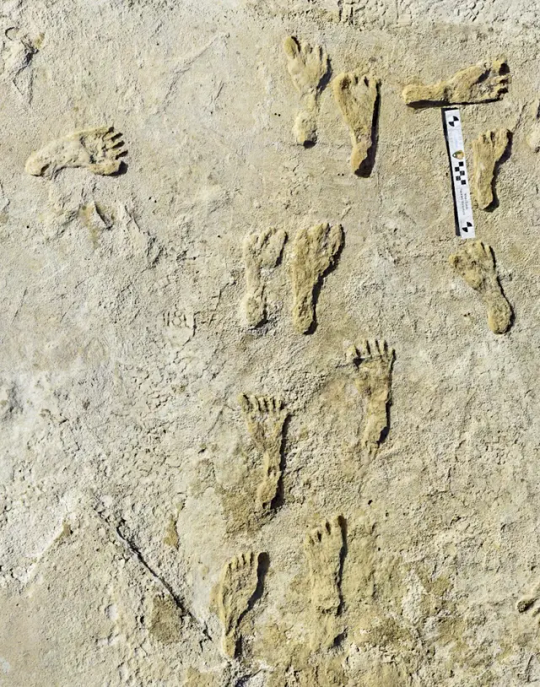

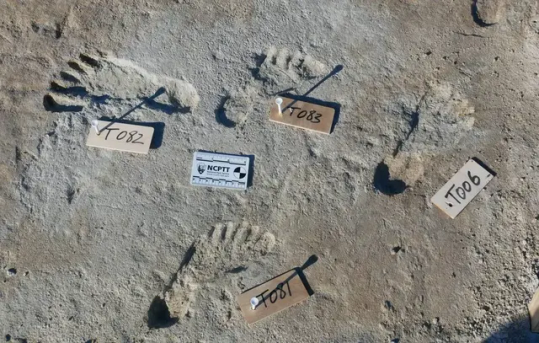
Thomas Stafford, an independent archaeological geologist in Albuquerque, New Mexico, who was not involved in the study, said he “was a bit skeptical before” but now is convinced.
The new study isolated about 75,000 grains of pure pollen from the same sedimentary layer that contained the footprints.
“Dating pollen is arduous and nail-biting,” said Kathleen Springer, a research geologist at the US Geological Survey and a co-author of the new paper.
Ancient footprints of any kind can provide archaeologists with a snapshot of a moment in time. While other archeological sites in the Americas point to similar date ranges – including pendants carved from giant ground sloth remains in Brazil – scientists still question whether such materials really indicate human presence.
“White Sands is unique because there’s no question these footprints were left by people, it’s not ambiguous,” said Jennifer Raff, an anthropological geneticist at the University of Kansas, who was not involved in the study.

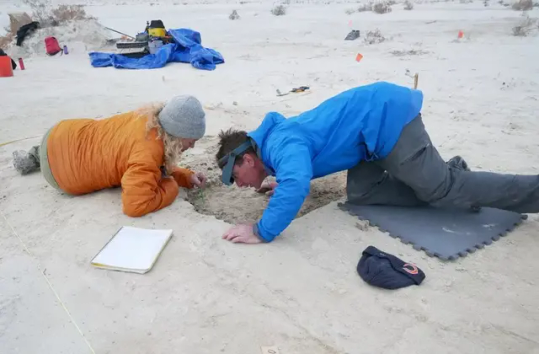
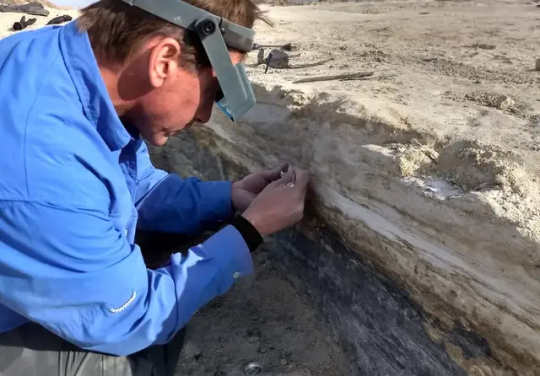

#New Mexico Footprints are Oldest Sign of Humans in Americas#fossil#fossil footprints#White Sands national park#ancient artifacts#geology#geologist#archeology#archeolgst#history#history news#ancient history#ancient culture#ancient civilizations#ancient man
656 notes
·
View notes
Photo
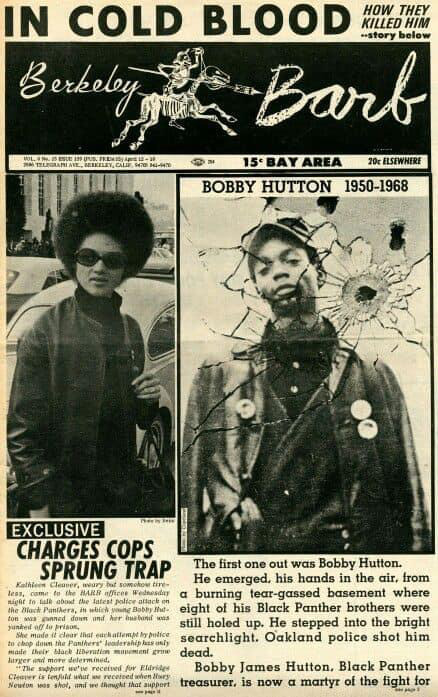
On the night of April 6, 1968, Hutton was killed by Oakland Police officers after Eldridge Cleaver led him and twelve other Panthers in a confrontation with the Oakland Police, during which two officers were seriously wounded by multiple gunshots. The confrontation turned into a shoot-out between the Panthers and the Oakland police at a house in West Oakland. About 90 minutes later Hutton and Cleaver surrendered after the police tear-gassed the building.
The impetus for the confrontation was the assassination of Martin Luther King Jr.
Despite the fact that he had instructed Hutton to strip down to his underwear to demonstrate that he was unarmed, Eldridge Cleaver stated that police shot Hutton more than twelve times as he was surrendering. Another account from Kathleen Cleaver states that Hutton was embarrassed to remove his clothing and so he only took off his shirt and kept on his pants. While the police maintained that he attempted to run away and ignored orders to stop, Eldridge Cleaver stated that Hutton was shot by the police with his hands up. Cleaver also claimed that an Oakland police officer who witnessed the shoot-out later told him: "What they did was first-degree murder." Cleaver and two police officers were also wounded. Bobby Seale, a fellow Black Panther, has since speculated that the police shot Bobby Hutton thinking they were shooting him.
Hutton's funeral was held on April 12 at the Ephesians Church of God in Berkeley, California. About 1,500 people attended the funeral. A rally held afterwards at the Alameda County Courthouse near Lake Merritt in Oakland which was attended by over 2,000 people, and included a eulogy by actor Marlon Brando. He was buried at Mountain View Cemetery in Oakland.
Bobby Hutton's death at the hands of the Oakland police was seen by those sympathetic to the Black Panther Party as an example of police brutality against blacks. Hutton was the first Panther to die and "immediately became a martyr for the cause of black power."
72 notes
·
View notes